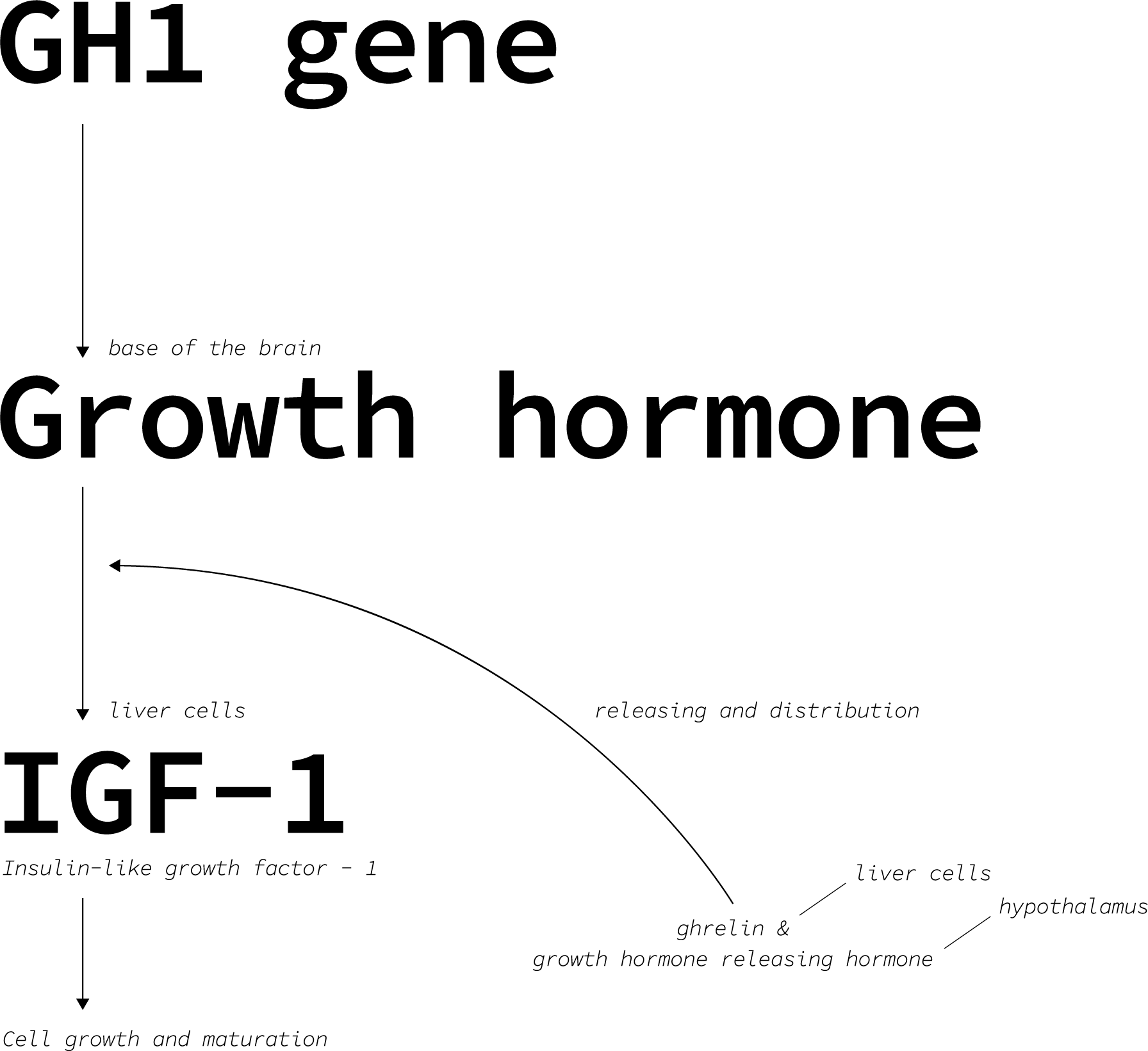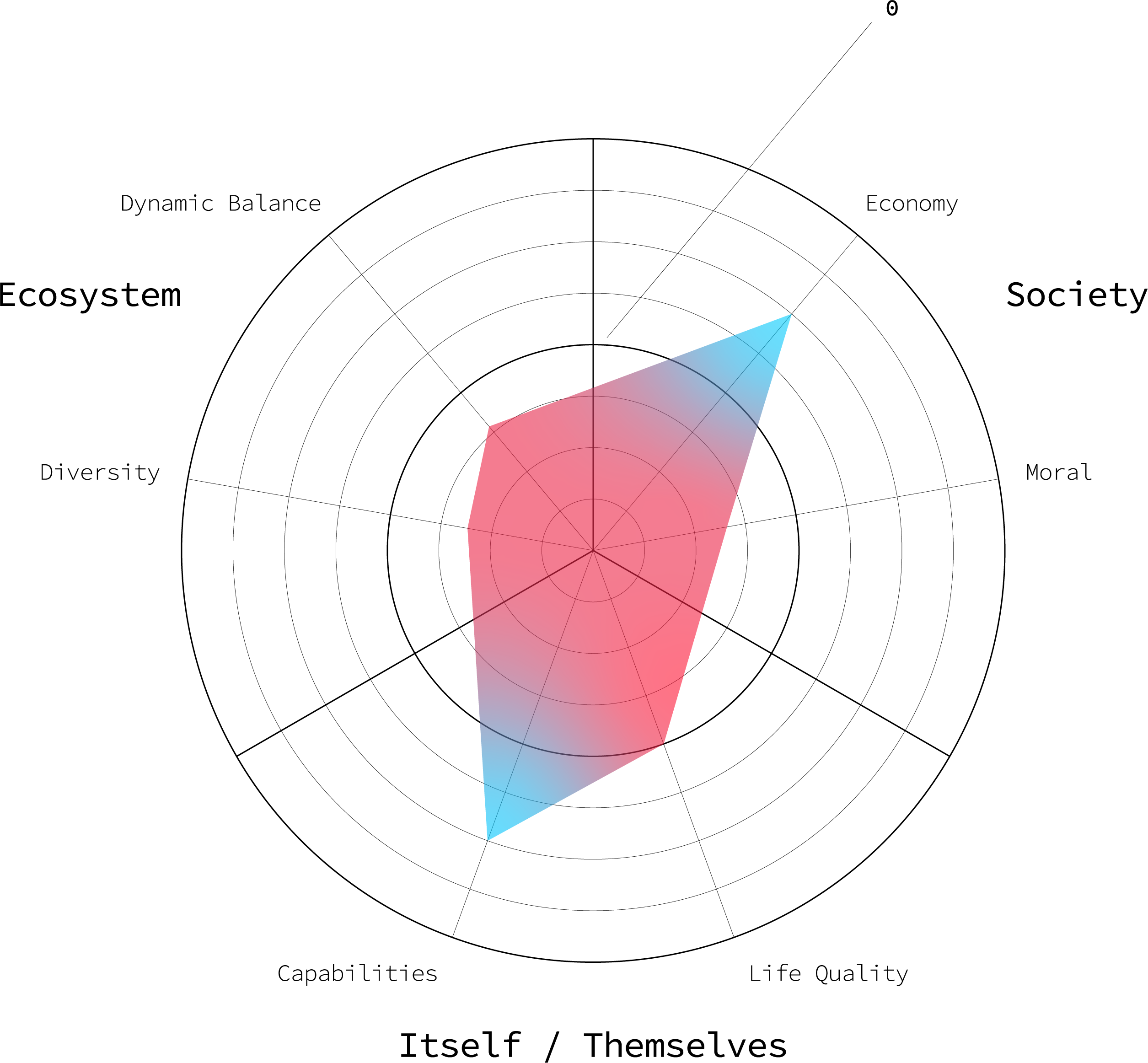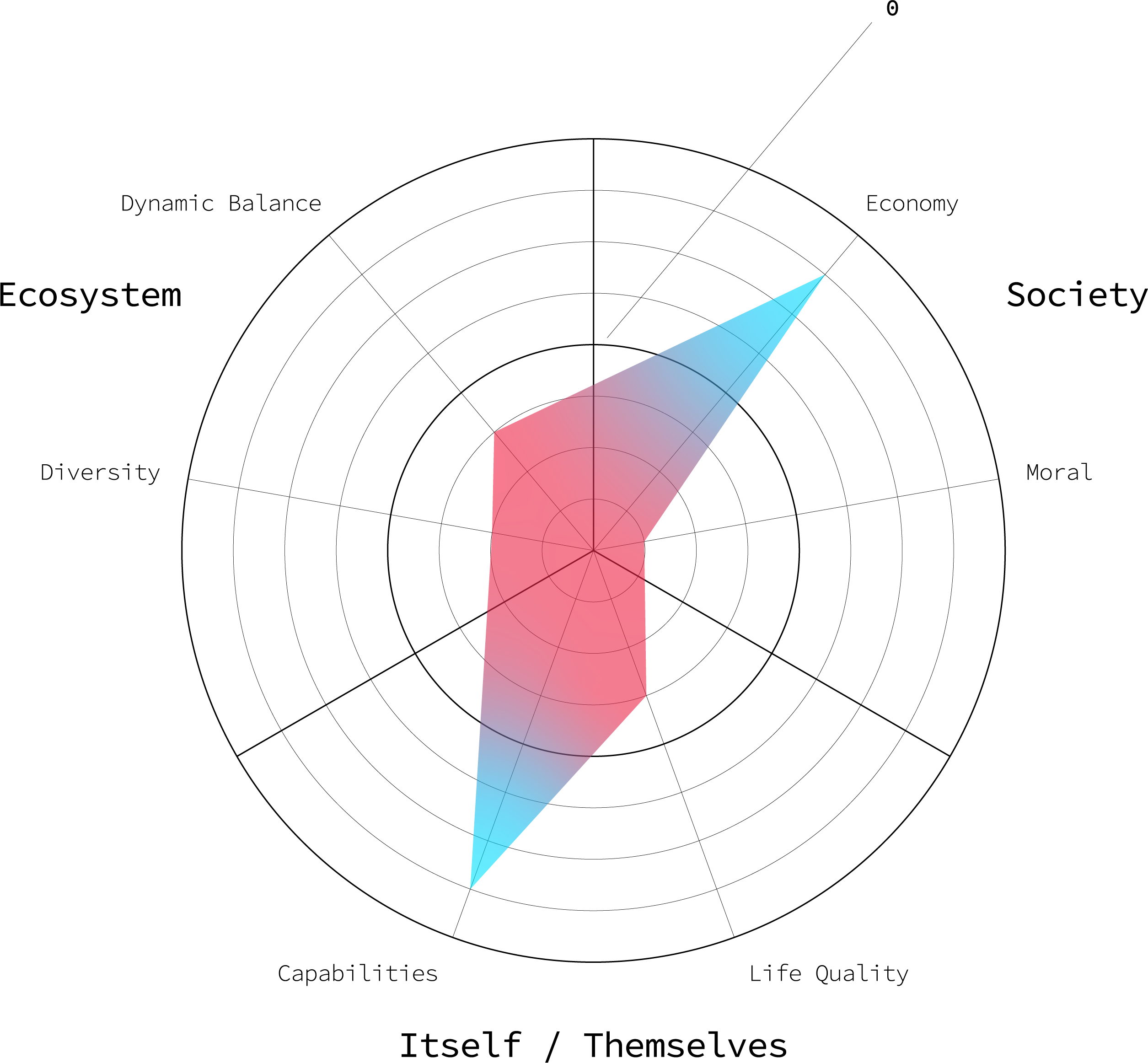Readings #
Scale Matters #
– A Fantasy of Gene Drive

What if we can modify scales of creatures with Gene Drive?

How we grow? #
The GH1 gene provides instructions for making the growth hormone protein. Growth hormone is produced in the growth-stimulating somatotropic cells of the pituitary gland, which is located at the base of the brain. Growth hormone is necessary for the normal growth of the body’s bones and tissues. The production of growth hormone is triggered when two other hormones are turned on (activated): ghrelin, which is produced in the stomach; and growth hormone releasing hormone, which is produced in a part of the brain called the hypothalamus. Ghrelin and growth hormone releasing hormone also stimulate the release of growth hormone from the pituitary gland. The release of growth hormone into the body peaks during puberty and reaches a low point at about age 55.
Cells in the liver respond to growth hormone and trigger the production of a protein called insulin-like growth factor-I (IGF-I). This protein stimulates cell growth and cell maturation (differentiation) in many different tissues, including bone. The production of IGF-I by the actions of growth hormone is a major contributor to the promotion of growth.
Growth hormone also plays a role in many chemical reactions (metabolic processes) in the body. By acting on specific tissues, growth hormone is involved in protein production and the breakdown (metabolism) of fats and carbohydrates.
What is Teacup dog? #
Teacup dogs are animals that have been bred to be as small as humanly—or shall we say caninely—possible. Most dogs considered to be teacups weigh 5 pounds or less, says Los Angeles-based veterinarian Dr. Patrick Mahaney. You’ll find teacup versions of many already-small dog breeds, including teacup Poodles, teacup Pugs, and teacup Yorkies. Other popular teacup breeds include Maltese, Pomeranians, and Shih Tzus.
To create teacup dogs, breeders pair the so-called “runts” of the litters to make the smallest animal possible, says Dr. Cathy Meeks, a board-certified internal medicine specialist and a group medical director at BluePearl Veterinary Partners in Tampa, Florida. But sometimes the dogs selected for breeding are small because of a birth defect or other medical condition.
Doctors say common health issues for teacup dogs include hypoglycemia, heart defects, collapsing trachea, seizures, respiratory problems, digestive problems, and blindness. The breeding practices can also lead to an increased risk for liver shunts, says Meeks. Liver shunts are often congenital birth defects in dogs that affect the liver’s ability to flush out toxins.
20% of teacup dogs die within 3 month after birth.
Stage one #
We, with Gene Drive, make tiny pets everywhere in the cities.

Nowadays, people are already “crazy” about tiny animals that are pet-able in home. However, these teacup-sized dogs or cats have severe health problems, with unmatured organs and bones, and not well developed intelligence. With Gene Drive, however, by controlling GH1 that controls body growth only, and the genes producing hormone that controls the releasing and distributing Growth Hormone, we can thus determinedly make animals smaller by stopping their bone and muscle growth, while keeping the development and maturation of their organs.
Z generation youngsters are already obsessed with those small and cute petty doggy and catty. With Gene Drive, however, we could make even more animals - horse, pig, eagle, or cow - pet-able and available for people to choose from, by just making them smaller. Even for traditional pet industries, tight living space for most of citizens and limited expenses people have will all persuade people from planning to raise a full-scale pet. And tiny, growth-controlled animals might be a better choice.
-
A Huge Growth of Pet industry and Pet Care Industry
There’re more than enough reasons for people to do it. The current pet industry is 75 billion dollars (2018), and pet care industry is estimated 225 billion dollars this year (2019). And these are only with dogs and cats as “main-stream” pets. We can never imagine how the market would grow with much more “interesting” species being pets. Also, tiny pets are inevitably weaker and easier to get hurt, and we can see a even greater growth in the pet care industry. Zoologists will start to find jobs as veterinaries. -
More Homeless Abandoned Pets
-
More Wild Animal Caught for Experiments
Stage Two #
We, with Gene Drive, breed scale-modified animals everywhere, from city to countryside.

Then there’s no reason that we shouldn’t apply this technology to the whole ecosystem and all potentially-benefited industries. If we wanted, we could open the encyclopedia of all species on this planet, and adjust their height and weight based on our own needs: make them more beneficial to us, or less dangerous for small and weak people. The whole ecosystem will have to suffer a major change of every part of it.
Animal husbandry, such as breeding of pig and cow, might be benefited from it by having bigger livestock with higher weight-surface ratio. If indeterminate growers such as sharks and crocodiles, we could simply terminate their growth at any age we’d like to, and avoid potential danger. For alien invasive species, we could also make them less competitive than original breeds by making them smaller and weaker. (This might be a slower process since smaller individuals are also more likely to be less appealing to get opportunities to breed. People might need to progressively shrink their body.)
Stage Three #
We, with Gene Drive, make ourselves smaller and bigger.

The final stage of this carnival is the re-scaling of the scaler: human beings. After being benefited from the re-scaled world of other species, we can never hold back our desire and temptation to re-scale ourselves to take full advantage of this technology. Being high will no longer be a semi-predictable characteristic of our body, but a priceable commodity for people to differentiate themselves from others. The whole society, and its game rules, will be restructured. We’ll see giants and dwarves in our life doing different works.
-
A Clear and Lawful Social Class Division
As we’ll have very different appearance - not in a way of aesthetics but strength, height, and capabilities, it’s hard not to have new laws and regulations for this newly formed society. Lower class people will be assigned to specific jobs and genetically modified to specific height tuned for that job. For example, coal digging or programming both doesn’t require being tall, and short people save employers' space. We’ll eventually find “perfect scale” for people to do specific jobs, and people with or without the wanted gene will be very hard to switch their jobs, to get a different pay, and make a different life. This will be the start of Genetic Discrimination. -
The Difference Will Be More and More Prominent
Growth gene is accumulative. So after Gene Drive, not only all the accessors will maintain the height, but also will they become taller and taller, or shorter and shorter, based on the gene from parents. The class divisions will only be solidified. -
Scale Can Be Controlled As a Whole, but Also As Parts
We’ll also target hormone differently to specific parts of the body.
The reason why I divide the whole process into three stages is that we, human, will definitely inevitably go through all the periods once the technology is accessible to us. And with three differentiated stages, we could see a clearer clue of how the progress of technology, mixed with desire and the taste if this commodity society, might affect our community in either good or bad ways. The whole story starts from a simple and leisure request from normal citizens, and it could potentially develop to a catastrophe for the whole society and ecosystem. From one stage to another, you’ll always find it reasonable, however, when looking back from the third stage to the status quo, you’ll find how crazy and pathological things we’ve done.
Reference #
- Which Animals Never Stop Growing?
- The Truth About Teacup Dogs
- GH1 gene
- Graphical representation of phenotype/gene relationship(s) associated with GH1
- Why were so many prehistoric animals so big?
- The Biggest Trends In The Pet Industry
- Pet Industry Market Size & Ownership Statistics
- Moose in Canada
- Can evolution be predicted? For at least one important biological trait—body size—the answer appears to be yes.
- Pet Satisfaction among Dog Owners
- Isolated growth hormone deficiency
- Top 10 Cutest Teacup Dogs That Can Fit in Your Pocket
- If You Love Animals, Never Buy A Teacup Dog
Week Three #
We can never overestimate the power of fundamentals: microscope, a concept from 500 years ago, still serves as an essential equipment for biology experiments, plays an unreplaceable role of bringing younger generations into the field, and inspires the invention of its successor including transmission electron microscopy (TEM) as well as scanning electron microscopy (SEM), which enable modern research of much smaller scale biotechnologies. As far as I’m concerned, one fact that isolated biology apart from other science was that, for a long time, we couldn’t find one formula or law to summarize the rule of the world of life - like Newton or Gaussian’s laws. And the discovery of gene was definitely a break-through. Thanks to microscopy, we could see smaller things and dig deeper. In addition to Microscopy, are there other concepts in life science area that that also had inspired us to achieve what we achieved?
Another fact that we could never overestimate is how accessible knowledge and “mysterious power” can be, given the fact that we can produce a microscope with as least as $0.58. With a background of product design, this topic suddenly arose my interests. Then I searched about different kinds of (ultra-)low-cost and accessible bio equipment (for large-scale manufacturing). And here’s what I found:
- BioBits educational kits ring synthetic and molecular biology experiments into K-12 classrooms.
- Generic Lab Equipment from Hackteria introduces ways to DIY bio equipments including microscopy, incubator, and spectroscopy.
- Low-Cost Equipment for Photochemical Reactions
- Open-Source 3-D Platform for Low-Cost Scientific Instrument Ecosystem - a compact system for various scientific purposes.
Are there other opportunities or possibilities to make other kinds of equipment or experiment process more accessible for kids and community?
Reference #
Week Two #
A high school student is cloning DNA at home. A former NASA scientist is live streaming experiments in his garage. A marketplace called Science Exchange is selling cloned DNA fragments that, potentially, could be used for both good or ill. All these facts are pointing to one clue: we are inevitably coming closer and closer to an era where most bio knowledge and experiments are decentralized and accessible for everyone. Community labs are awesome and form an unreplaceable piece of $370 billion bioeconomy. But we cannot ignore another fact as well: Keoni Gandall, the high-schooler, gained his fellowship in Stanford after experiments in his home, and Josiah Zayner, the former NASA scientist, worked for the government department and is still active in acknowledged academia conferences. People always say opportunities and possibilities in bio in this century are as promising as those in cyber industry from the past decades (and much much more). And after years of compiling and simplifying, coding is easy enough for everyone to learn and do. However, while “professional” programming education is now available from Youtube to summer schools, “research” labs are still only among the top tire universities. Similarly, what we should expect from the increasing community labs might be the introductory courses and accessible equipment that would bring more people into the field.
Reference #
- As D.I.Y. Gene Editing Gains Popularity, ‘Someone Is Going to Get Hurt’
- Science Exchange
- TWEAKING GENES IN YOUR GARAGE: BIOHACKING BETWEEN ACTIVISM AND ENTREPRENEURSHIP
- On Flatbush Avenue, Seven Stories Full of Ideas
- Biohackers are about open-access to science, not DIY pandemics. Stop misrepresenting us
CRISPR #
This is a quick note of CRISPR, a topic to familiarize and workshop in class.
CRISPR is changing how we do science. (Phillip Sharp)
-
What Clustered regularly interspaced short palindromic repeats is a family of DNA sequences found within the genomes of prokaryotic organisms such as bacteria and archaea.
Cas9 (CRISPR-associated protein 9) is an enzyme that uses CRISPR sequences as a guide to recognize and cleave specific strands of DNA that are complementary to the CRISPR sequence.
Cas9 enzymes together with CRISPR sequences form the basis of a technology known as CRISPR-Cas9 that can be used to edit genes within organisms.
The CRISPR-Cas system is a prokaryotic immune system that confers resistance to foreign genetic elements such as those present within plasmids and phages that provides a form of acquired immunity. RNA harboring the spacer sequence helps Cas (CRISPR-associated) proteins recognize and cut foreign pathogenic DNA. Other RNA-guided Cas proteins cut foreign RNA. CRISPR are found in approximately 50% of sequenced bacterial genomes and nearly 90% of sequenced archaea.
-
How Researchers create a small piece of RNA with a short"guide" sequence that attaches (binds) to a specific target sequence of DNA in a genome. The RNA also binds to the Cas9 enzyme. As in bacteria, the modified RNA is used to recognize the DNA sequence, and the Cas9 enzyme cuts the DNA at the targeted location. Although Cas9 is the enzyme that is used most often, other enzymes (for example Cpf1) can also be used. Once the DNA is cut, researchers use the cell’s own DNA repair machinery to add or delete pieces of genetic material, or to make changes to the DNA by replacing an existing segment with a customized DNA sequence.
CRISPR-Cas9 is proving to be an efficient and customizable alternative to other existing genome editing tools. Since the CRISPR-Cas9 system itself is capable of cutting DNA strands, CRISPRs do not need to be paired with separate cleaving enzymes as other tools do. They can also easily be matched with tailor-made “guide” RNA (gRNA) sequences designed to lead them to their DNA targets. Tens of thousands of such gRNA sequences have already been created and are available to the research community. CRISPR-Cas9 can also be used to target multiple genes simultaneously, which is another advantage that sets it apart from other gene-editing tools.
-
Who First discovered in archaea (and later in bacteria) by Francisco Mojica, a scientist at the University of Alicante in Spain.
CRISPR genome editing allows scientists to quickly create cell and animal models, which researchers can use to accelerate research into diseases such as cancer and mental illness. In addition, CRISPR is now being developed as a rapid diagnostic. To help encourage this type of research worldwide, Feng Zhang and his team have trained thousands of researchers in the use of CRISPR genome editing technology through direct education and by sharing more than 40,000 CRISPR components with academic laboratories around the world.
References #
- CRISPR - Wikipedia
- Meet one of the world’s most groundbreaking scientists.
- ZHANG LAB
- Sanhana Lab
- Feng Zhang: The Future of Gene Editing
- What are genome editing and CRISPR-Cas9?
- QUESTIONS AND ANSWERS ABOUT CRISPR
- CRISPR: Gene editing and beyond
- CRISPR Explained
- Gene editing can now change an entire species – forever | Jennifer Kahn
- What you need to know about CRISPR | Ellen Jorgensen